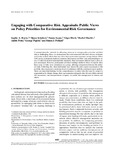Engaging with Comparative Risk Appraisals: Public Views on Policy Priorities for Environmental Risk Governance
| dc.contributor.author | Rocks, SA | |
| dc.contributor.author | Schubert, I | |
| dc.contributor.author | Soane, E | |
| dc.contributor.author | Black, E | |
| dc.contributor.author | Muckle, R | |
| dc.contributor.author | Petts, J | |
| dc.contributor.author | Prpich, G | |
| dc.contributor.author | Pollard, SJ | |
| dc.date.accessioned | 2017-12-11T10:59:49Z | |
| dc.date.available | 2017-12-11T10:59:49Z | |
| dc.date.issued | 2017-09 | |
| dc.identifier.issn | 0272-4332 | |
| dc.identifier.issn | 1539-6924 | |
| dc.identifier.uri | http://hdl.handle.net/10026.1/10399 | |
| dc.description.abstract |
<jats:title>Abstract</jats:title><jats:p>Communicating the rationale for allocating resources to manage policy priorities and their risks is challenging. Here, we demonstrate that environmental risks have diverse attributes and locales in their effects that may drive disproportionate responses among citizens. When 2,065 survey participants deployed summary information and their own understanding to assess 12 policy‐level environmental risks singularly, their assessment differed from a prior expert assessment. However, participants provided rankings similar to those of experts when these same 12 risks were considered as a group, allowing comparison between the different risks. Following this, when individuals were shown the prior expert assessment of this portfolio, they expressed a moderate level of confidence with the combined expert analysis. These are important findings for the comprehension of policy risks that may be subject to augmentation by climate change, their representation alongside other threats within national risk assessments, and interpretations of agency for public risk management by citizens and others.</jats:p> | |
| dc.format.extent | 1683-1692 | |
| dc.format.medium | Print-Electronic | |
| dc.language | en | |
| dc.language.iso | en | |
| dc.publisher | Wiley | |
| dc.subject | Environment | |
| dc.subject | policy prioritization | |
| dc.subject | strategic risk | |
| dc.title | Engaging with Comparative Risk Appraisals: Public Views on Policy Priorities for Environmental Risk Governance | |
| dc.type | journal-article | |
| dc.type | Journal Article | |
| dc.type | Research Support, Non-U.S. Gov't | |
| plymouth.author-url | https://www.webofscience.com/api/gateway?GWVersion=2&SrcApp=PARTNER_APP&SrcAuth=LinksAMR&KeyUT=WOS:000410203600006&DestLinkType=FullRecord&DestApp=ALL_WOS&UsrCustomerID=11bb513d99f797142bcfeffcc58ea008 | |
| plymouth.issue | 9 | |
| plymouth.volume | 37 | |
| plymouth.publication-status | Published | |
| plymouth.journal | Risk Analysis | |
| dc.identifier.doi | 10.1111/risa.12735 | |
| plymouth.organisational-group | /Plymouth | |
| plymouth.organisational-group | /Plymouth/Users by role | |
| plymouth.organisational-group | /Plymouth/Users by role/Academics | |
| dc.publisher.place | United States | |
| dcterms.dateAccepted | 2016-09-11 | |
| dc.identifier.eissn | 1539-6924 | |
| dc.rights.embargoperiod | Not known | |
| rioxxterms.versionofrecord | 10.1111/risa.12735 | |
| rioxxterms.licenseref.uri | http://www.rioxx.net/licenses/all-rights-reserved | |
| rioxxterms.licenseref.startdate | 2017-09 | |
| rioxxterms.type | Journal Article/Review |


